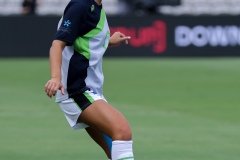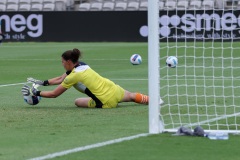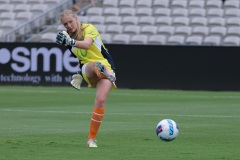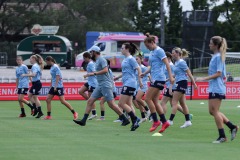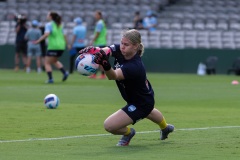

It’s been a long ten years since March’s grand final, but thank heavens – the Dub is back!
The 2020-21 W-League season will consist of nine teams playing 12 matches each across 14 rounds; the draw is imbalanced – teams aren’t playing a full home-and-away fixture – but with no international breaks this season, it’s a straight sprint to the finals in April 2021.
Once again, Beyond90 has worn out the abacuses and run all the formulas to bring you our definitive guide to this season’s fixtures’ winners and losers.
Pencil it in! ✏️
All the Westfield #WLeague Season 2020/21 Fixtures are here 👉 https://t.co/6LJNQNnRK7 pic.twitter.com/1KgcNARP0b
— Westfield W-League (@WLeague) November 30, 2020
LOSERS
Canberra United
After three years in the post-season wilderness, Canberra have made a number of brilliant acquisitions: coach Vicki Linton has signed on after several years in the United States, club legends Michelle Heyman, Kendall Fletcher and Grace Maher have returned, and New Zealand striker Paige Satchell joins from Bundesliga club SC Sand.
And yet, with all those positives, Canberra have inarguably the most difficult draw of any team in the competition; United is the only club in the W-League drawn to three of last season’s semi-finalists – Melbourne City, Melbourne Victory, and Western Sydney – both home and away, and the side will also have to play three genuine contenders – Victory, Western Sydney, and Brisbane – in the final rounds.
Excited to create more history at Viking Park this season! pic.twitter.com/dSAfEk2UB7
— Canberra United (@CanberraUnited) November 23, 2020
Even without those fixtures, it could prove to be a topsy-turvy season. Traditional home McKellar Park is unavailable due to issues arising from the coronavirus pandemic, forcing the club to move its matches to Viking Park, a verdant multi-sport venue in the city’s south. While the club has only ever lost one of its ten local fixtures away from McKellar, the minutiae of different grounds always take time to become familiar, meaning United will need a chance to settle into their new surrounds.
With one of the most talented and diverse rosters in the league but the hardest draw on paper, Linton will have her work cut out if Canberra is to retake its spot in the promised land of the playoffs.
Adelaide United
Once again playing the majority of fixtures at Marden Sports Complex, Adelaide will have to make do with kicking off a number of games at 3.30pm or 4pm local time; the match against Newcastle in Round 7 is one that sticks out in particular, with the early kick-off in February potentially necessitating water breaks or even postponements due to extreme heat.
The latter third of the draw could prove difficult for the Reds as well, with back-to-back away trips to opposite sides of the country to face Perth and Sydney, followed by visits from a resurgent Brisbane and always-powerful Melbourne City to close out the side’s bracket. New coach Adrian Stenta will no doubt be keen to prove the doubters wrong in his first season at the helm, but those challenges will loom large as the season progresses.
WINNERS
Sydney
It must be difficult being Sydney: perennial contenders, three of the best home venues in the league, and a seemingly-endless talent pool from which to sign players. Those factors, as well as the recent success of the club’s men’s side, have seen the Sky Blues blessed with a massive four home double-headers this season.
Two huge double headers are the highlight of our @WLeague fixtures over December and January!
Note those ones down in your calendar 📆 #SydneyIsSkyBlue pic.twitter.com/f2kvbuRKBU
— Sydney FC (@SydneyFC) November 30, 2020
A Double Derby in mid-January at the Olympic Stadium should see a massive crowd funnel in for the early game, and back-to-back matches against Adelaide in Wollongong and Melbourne Victory at Kogarah in March should – hideous global pandemic permitting – give even more fans the chance to watch their team in the flesh.
Add to that no travel outside NSW for the whole second half of the season AND a bye in the week before the finals start, and Sydney fans should be more than happy with what the Fixture Fairy has delivered them this year.
Brisbane Roar
Of all teams in the 2020-21 competition, Brisbane have by far the easiest fixture when compared to last season’s results. Starting its campaign away in the City of Churches, half of Brisbane’s fixture list is made up of last year’s bottom three teams – Adelaide, Perth, and Newcastle – meaning Jake Goodship’s charges will only play the top two sides – Melbourne City and Victory respectively – once each.
Brisbane also have the most Thursday night games this season with four. Add to this a Round 8 Friday night fixture against Adelaide and a Round 11 Sunday evening showdown with Melbourne City, and you’ve got half of the season played under lights and in the comparative cool of the evening. Whether this will allow the Queenslanders the opportunity to play a slicker and more combative style of football, only time will tell.
The draw is here & you know what to do now Roar fans 😏 @WLeague 2020/21 memberships are ON SALE NOW! 🤩
Be at all six home matches from just $45 👉 https://t.co/k3we3dnkO7 pic.twitter.com/zHSm9dBEkF
— Brisbane Roar FC (@brisbaneroar) December 1, 2020
ABC viewers
This season offers those viewers tuning in on the ABC an embarrassment of riches when it comes to football. In just the first three rounds, fans can watch Western Sydney taking on Melbourne Victory from beautiful Western Sydney Stadium, before travelling south to Canberra to see the Pride of the Capital do battle with Sydney and Melbourne City in successive weeks.
Every team aside from Perth will feature at least twice on Aunty’s screens. Adelaide and Canberra clock up the most TV time with both having five matches on free-to-air, while four of Canberra’s six home games will be broadcast live from Viking Park. Such a diverse offering from venues big and small means there’s no reason why ABC viewers should be missing a minute of the action this season!


